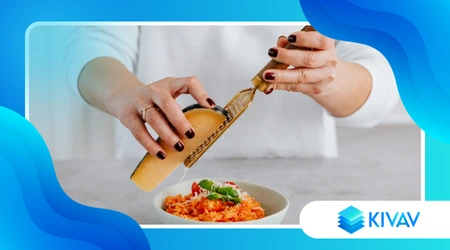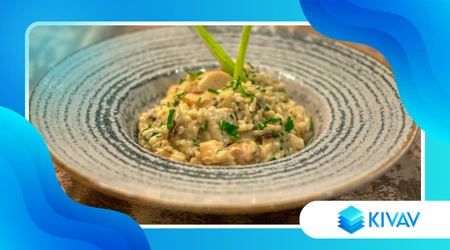How to Cook a Creamy Parmesan Risotto

Creamy Parmesan Risotto It represents the essence of Italian cuisine: few ingredients, impeccable technique, and a result that conquers at the first bite.
Announcements
But what makes it so special? It's not just a question of taste, but of balancing science and tradition.
According to a survey by the Agri-food Observatory (2025), 78% of Italians consider it a dish to be mastered by anyone who loves fine cuisine.
Making a perfect risotto requires attention to detail, from choosing the rice to the final creaming.
Imagine a dish where every grain is al dente, wrapped in a velvety creaminess, with the Parmesan enhancing without overpowering.
Announcements
It's an experience that goes beyond a simple meal, almost becoming a gastronomic ritual.
Choosing the Ingredients: The Foundation of a Masterpiece
Rice is the undisputed star. Carnaroli, for its resistance, or Vialone Nano, more delicate but equally rich in starch, are the ideal varieties.
A common mistake? Using rice that cooks too quickly, which releases too little starch and compromises the texture.
The broth must be prepared with care. If vegetable, carrots, celery, and onion are best, cooked slowly to extract all the flavor. If meat, a chicken or beef stock adds depth.
A little-known trick? Add a small amount of lemon zest to the broth to balance the richness of the cheese.
Parmigiano Reggiano, preferably aged at least 24 months, isn't just a finishing touch, but a structural ingredient. Freshly grated, it melts evenly, creating that unmistakable creaminess.
The Technique: From Sautéing to Mantecatura
The secret begins with a sauté of golden onion, never burnt to avoid a bitter aftertaste. The rice is toasted for a few minutes, until the grains become translucent at the edges.
+Genoese focaccia: soft and tasty
This step seals in the starches, ensuring even cooking.
Adding broth is an art. It must be ladled in, never all at once, and kept at a constant temperature.
A useful analogy? Think of a building: if the broth is the mortar, it must be added little by little to hold the structure together.
The final creaming, with cold butter and Parmesan, is the final touch. Stir vigorously, but slowly, to incorporate air and create a silky texture.
Some chefs add a spoonful of fresh cream for an even more enveloping effect, but purist tradition prefers to avoid it.
Common Mistakes and How to Fix Them
One of the most common mistakes is cooking risotto over too high a heat. The result? Hard grains inside and an inconsistent creaminess. The solution? Patience and a low heat, just like when preparing a delicate sauce.
Another mistake is grating Parmesan ahead of time. Oxidation alters its flavor, making it less aromatic. It's best to grate it immediately, storing it in a covered bowl until ready to use.
Innovation and Tradition: Contemporary Variants
Some chefs experiment with unusual broths, such as black truffle or dark beer, to give a modern twist to the classic.
An original example? A risotto creamed with Parmesan and orange zest, which adds a citrusy note without overwhelming the dish.
Another trend is the use of sous-vide techniques for cooking rice, ensuring a precision impossible with traditional methods.
++How to make lump-free béchamel sauce
But be careful: without the right initial toasting, the risotto loses its rustic character.
Creamy Parmesan Risotto in the Home Kitchen
Even at home, with a few tricks, you can achieve a result worthy of a starred restaurant.
For example, using a pan with a thick bottom distributes heat evenly, avoiding overcooking spots.
Another practical tip? Keep a cup of hot broth aside after cooking. If the risotto dries out too much on the plate, a final ladleful will restore it to perfection.

The Importance of Broth: The Foundation of Flavor
A well-prepared broth is the soul of the creamy parmesan risottoIt should never be a simple hot liquid, but a concentration of flavors that binds with the rice. A little-known trick?
You can also use vegetable scraps, such as the outer leaves of leeks or the stems of parsley, to create a more complex broth without waste.
If you opt for a meat broth, slow cooking (at least 4 hours) extracts collagen, giving a fuller texture.
Remember: the broth must always be at a near-boiling temperature when added to the rice, otherwise it will interrupt the cooking and ruin the consistency.
The Role of Parmesan: More Than a Simple Condiment
Parmigiano Reggiano isn't just an ingredient, but a co-protagonist that influences texture and flavor. Research from the University of Bologna (2025) demonstrated that the natural glutamate crystals present in the aged cheese enhance umami, creating a more intense perception of creaminess.
For best results, avoid pre-grated versions: they oxidize and lose up to 40% of their aroma. A chef's tip?
Once cooked, set aside a small amount of freshly grated Parmesan cheese to grate directly onto the dish for a final burst of flavor.
The Science of Creaming: Where Creaminess Comes From
This crucial step combines physics and gastronomy. When cold butter is incorporated, its fat crystals surround the starch molecules, creating a stable emulsion.
Temperature plays a key role: if the rice is too hot, the butter separates; if it's too cold, it won't bind. An interesting experiment?
+Zeppole di San Giuseppe Recipe: A Dessert That Celebrates Tradition and Flavor
Try creaming part of the risotto with regular butter and the other with high-fat mountain butter: the difference in texture will be evident, demonstrating how much every detail counts.
Time and Patience: The Invisible Ingredients
In the age of haste, the creamy parmesan risotto A reminder to be slow remains. Each stage has its own precise timing: 2 minutes for toasting, 16-18 for cooking, 1-2 for stirring.
Respecting these intervals isn't pedantic, but chemical necessity. For example, rice starch takes at least 15 minutes to fully hydrate. What happens if you speed up the process?
The grains remain raw inside while they fall apart on the outside, ruining the balance. A kitchen clock is not optional, but an essential tool.
From the Restaurant to Home: Adapting Professional Techniques
Even without chef's equipment, you can apply some professional secrets. For example, many restaurants use the "allungo" method: after creaming, they let the risotto rest for 1 minute, covered, to allow the starches to settle.
At home, a lid and a cloth over the pot are all you need. Another trick? Use two wooden spoons instead of one: the double scooping incorporates more air, lightening the texture.
And for those who don't have one broth Homemade? A quality stock cube dissolved in boiling water with a tablespoon of white wine can be an acceptable alternative in an emergency, though not ideal.
Conclusion
The creamy parmesan risotto It's more than a recipe: it's a lesson in patience, technique, and respect for the ingredients.
Whether you're a professional chef or an avid enthusiast, mastering this dish means delving into the heart of Italian cuisine. So, why not try it tonight?
Table: Ideal Cooking Parameters
| Phase | Recommended Time | Temperature |
|---|---|---|
| Toasting rice | 2-3 minutes | Average |
| Cooking | 16-18 minutes | Medium-low |
| Creaming | 1-2 minutes | Off |
Data extracted from “The Science of Risotto” (Gambero Rosso, 2024).
Frequently Asked Questions
What is the best type of rice for a creamy risotto?
Carnaroli and Vialone Nano are the best choices for their high starch content, which ensures creaminess without overcooking.
Can I replace the butter with olive oil?
You can, but the result will be less creamy. Cold butter is essential for the final creaming.
How can I save a risotto that's too dry?
Add a ladle of hot broth and stir vigorously. The creaminess will return within seconds.
